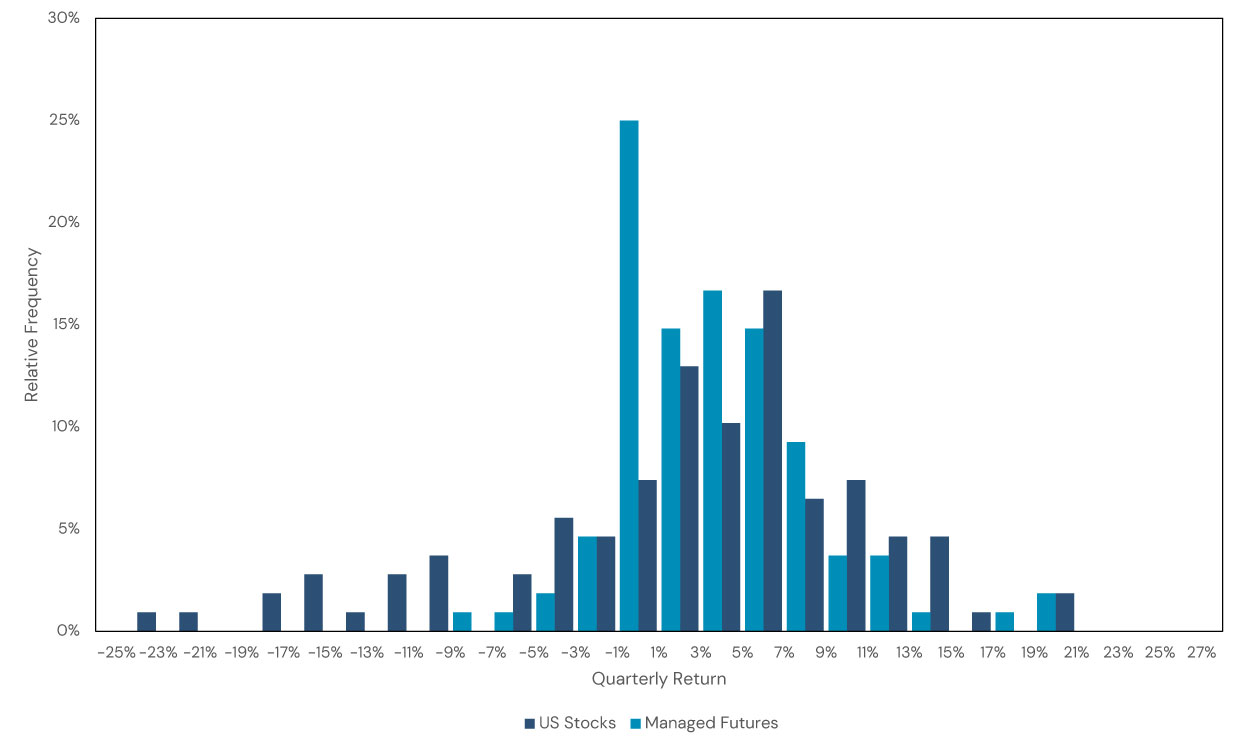Reclaim Core Exposure with Return Stacking
Overview
Advisors who have trimmed traditional stock and bond exposures to introduce alternative investments can use return stacking as a way to restore core allocations – without liquidating their alternatives. This approach may improve diversification, preserve portfolio intent, and support better client behavioral outcomes.
Key Topics
Portfolio Management, Alternatives, Portable Alpha, Return Stacking
Introduction
For many financial advisors, constructing portfolios that balance long-term return potential with diversification is an ongoing challenge – particularly when introducing alternative investments. While investments like private equity, private credit, real estate, and other alternative assets may enhance portfolio resilience, they often come at the expense of traditional exposures to equities and bonds.
But what if advisors didn’t need to choose? What if alternatives could remain in the portfolio without compromising the traditional 60/40 foundation?
This is where return stacking enters the conversation. By using tools that combine traditional asset class exposures – such as those that seek to deliver 100% exposure to equities and 100% exposure to bonds in a single position – advisors can overlay core exposures back onto an alternative-heavy portfolio. The result: potentially improved balance, diversified exposures, and a structure that may be easier for clients to hold through a full market cycle.
Let’s consider a common scenario. Over the last several years, an advisor has gradually incorporated various types of alternative investments into client portfolios. The resulting allocation might look something like: 50% equities; 30% bonds; and 20% alternatives.
While this structure introduces new return sources and diversification, it may leave some clients feeling underexposed to traditional markets—particularly in bull markets or relative to familiar benchmarks.
To address this, the advisor could sell 10% from equities and 10% from bonds, allocating that 20% into a fund that seeks to deliver 100% equity and 100% bond exposure. This effectively restores the 60/40 exposure without removing the alternatives allocation.
Register for our Advisor Center
Tools Center:
Easily backtest & explore different return stacking concepts
Model Portfolios:
Return stacked allocations, commentary and guidance designed
for a range of client risk profiles and goals
Future Thinking:
Receive up-to-date insights into the world of return stacking theory and practice
Figure 1: Restoring Traditional Stock/Bond Exposure
Source: Newfound Research. For illustrative purposes only.
The new portfolio would then look like: 60% equities; 40% bonds; and 20% alternatives.
The alternatives allocation remains intact, but the traditional core has been rebuilt—effectively creating an alternatives overlay.
This rebalancing method allows advisors to maintain exposure to hard-to-source or illiquid alternative positions without sacrificing the structural balance of the portfolio.
It treats alternatives as a foundational building block and overlays traditional exposures on top using return stacking. This can be especially helpful when unwinding or re-entering traditional markets would trigger tax consequences or market timing concerns.
From a behavioral standpoint, re-aligning portfolios to familiar benchmarks like a 60/40 allocation may increase client confidence—helping them stay invested in the strategy even with a meaningful exposure to less conventional assets.
From a construction standpoint, the strategy seeks to:
- Restore stock and bond exposures without removing existing alternatives exposure
- Preserve access to private or illiquid alternatives
- Add structural flexibility through overlays
- Maintain the portfolio’s intended function: growth, income, or diversification
Return stacking doesn’t require a complete overhaul of portfolio construction. It can be used tactically – especially for advisors who’ve already embraced alternatives but also want to maintain core market exposures.
By using tools that combine multiple exposures into a single position, advisors can pursue diversification goals without sacrificing traditional allocation targets.
As portfolios evolve over time, return stacking provides an adaptable framework that may help advisors navigate the tradeoffs between maintaining traditional exposures and adding alternative assets.
Key Takeaways for Financial Advisors
- Bridge the gap: Return stacking can be used to restore traditional 60/40 allocations even after introducing alternatives.
- Preserve alternatives: No need to sell hard-to-access or illiquid positions to regain equity and bond exposures.
- Improve flexibility: Use return stacking tactically as exposures shift across the portfolio.
- Behavioral benefits: Realigning with familiar benchmarks may help clients stay committed to the plan.
- Portfolio potential: Return stacking may support more diversified, resilient, and durable portfolios over time.

